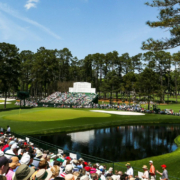I took a few walks this week. That’s not unusual, and this particular walk is one I’ve made perhaps two hundred times before. But this was a special version of that walk. Whenever I get to Augusta National for The Masters, I take part of each day I’m there to walk the back nine. And it’s the same walk every time. I usually make this walk with a friend or colleague but this week with no patrons and limited media, I took this walk alone.
The walk starts just behind the scoreboard to the right of the first fairway. That’s where the original pressroom used to be. A Quonset hut full of the legends of sports journalism before the explosion of media, that press room had a manual scoreboard at the front. It’s where the then PGA Tour Director of Information, Tom Place rescued a lost and bewildered 25-year-old version of me in 1979. It was replaced by the first permanent Press Building in the same place. And now, the golf cart shuttle from the magnificent new Press Building drops you in that same spot.
From there, the hill walking up next to the golf shop and skirting the famous oak tree by the clubhouse is usually worn with patron pedestrian traffic. But this week it was lush and green. And I was the only person there. The first fairway was open, no ropes, just small dark green dashes on the ground, a reminder of where to, and where not to walk. The walkway was marked by a couple of stakes on the ground but only a few maintenance cart tire tracks had passed that way.
Each time I walk by the golf shop, I have the same thought, about a story Jack Nicklaus told me. Chatting during construction of The King and The Bear course at World Golf Village, we were talking about the changes at Augusta in the era before they announced what they were doing to the golf course in the off season. Jack said after one of his wins, the following year he walked out of the golf shop, headed to the first tee. As with most courses of that era, the first tee was right outside the door. Jack’s play had made the game longer as Bobby Jones said, “he plays a game I’m not familiar with.” Nicklaus held his hands out in front of him, palms facing each other and in a very animated voice said, “But it wasn’t there, it was up there,” as he gestured and looked up the hill to his left. Going by the shop, I glanced to my right, looking for any hint of a former tee, but none to be found.
At the top of the hill, I was struck by how still it was. Just some security standing around, nothing going on under the oak tree, the first tee open without any restrictions.
I waited behind the ninth green on Tuesday as Fred Couples, Tiger Woods and Adam Scott finished the front nine, checking green speed and fairway slopes during their practice round.
I’ve known Fred since his win at the ’84 Players and he gestured for me to walk with him to the tenth tee. There were maybe four of us there, including the member assigned to the tee. I stood with Joey LaCava, Fred’s long time caddie who now works for Tiger just trying to blend in. As familiar as I was with the players and the setting, the situation was so different I was trying to be as unobtrusive as possible. Although they were working, it felt like a casual game among friends.
Fred mouthed “Wow,” to me as Tiger and Adam blasted three metals down the middle with a high draw, just like you’re supposed to there at ten. Fred hit driver, and the three walked to the clubhouse, leaving their shots in the fairway.
As the players walked away, the member in the green jacket asked me about the logo on my golf shirt. “I’ve played there and they let me buy a shirt,” I explained, somewhat sheepishly. . “I’m a member there,” he said. We spent the next ten minutes talking about golf in different parts of the country, a conversation that couldn’t have happened in any other year.
When Larry Mize won The Masters in 1987, he navigated around the golf course hitting fairways and greens en route to a spot in a playoff. He lead the tournament this year in driving accuracy through two rounds but a combination of lengthening the golf course and the shorter distance that comes with age, Mize, Langer and several other senior past champions oftentimes find themselves with a fairway metal or a hybrid in their hands on many of Augusta’s par four’s.
As I passed the eighteenth green on Friday, Mize had hit two solid shots but was still twenty yards short of the putting surface. I stopped as the only person nearby. I was in what normally is a high traffic area but alone, golf etiquette demanded I be still while Mize played. Trying to be very precise, chipping to a back left hole location, Mize’s shot caught the top of the bunker to the right of the green and rolled in. I didn’t dare move while Mize, obviously disappointed, still very professionally walked into the bunker and saved bogey with a beautiful, long sand wedge to two feet.
One of the things television can’t convey from Augusta National is the elevation changes on the golf course. Walking down next to the tenth and eleventh fairways, you could almost call it steep. Eleven is so directly downhill, that as a par four, it’s actually longer in yardage than the par five thirteenth. Halfway down the hill I had a bit of a wry smile, thinking I might not have been able to make this walk if the tournament was held as scheduled in April. Left hip replacement last November has been very successful but I’m still working on regaining the muscle strength in my left leg. I still struggle a bit downhill, but I’m not sure I’d have gotten even this far eight months ago.
By now on Tuesday, I was virtually alone.
I glanced to my right as a passed by the spot Bubba Watson hit that hook out of the woods to win in a playoff. A few hole monitors were just about to gather their things and finish their days work. We exchanged hellos and I stopped for a second when one asked me how I was doing. “Couldn’t be better,” I said. “I’m here.” “That’s true,” he answered, “Couldn’t be better.” I heard tee shots being hit in the distance on the fifteenth tee.
When I take this walk with somebody attending the Masters for the first time, at this point I usually take them around the back of ten and back up the little hill behind the eleventh tee. It’s a demanding tee shot out of that chute, especially since they added the trees to the right of the fairway. That’s one of my favorite spots in practice rounds or during the tournament. There aren’t many people back there, and the players walk right up and occasionally have to wait on their tee shots. Sometimes they’ll chat up the fans, it’s a little bit of a relaxed moment in an otherwise focused eighteen holes. In the era of persimmon head drivers, the echo through the tall pines of the crack of the club hitting the ball is the most unique, and satisfying golf sound I’ve ever heard.
When the TV station I worked for was the CBS affiliate, I used to scoot to the other side of the eleventh tee and take the short walk up the tree-lined, cinder roadway to the television compound. I knew most of the CBS production crew and the announcers, mainly thanks to my friendship with Pat Summerall. I’d spend time in Producer/Director Frank Chirkinian’s office listening to golf stories, mostly told by his “do everything” producer Chuck Will.
But not today.
Heading down right of the eleventh fairway on Tuesday I was very aware that I was alone. Nobody in sight. Nobody playing number eleven. Nobody on fifteen tee. Nobody on fourteen green. No players, no officials, no workers. I walked around the closed concession stand to Amen Corner, by myself, noticing there were no stands erected there, and still, nobody in sight.
During Friday and Saturday’s competition rounds, there were maybe twenty people at Amen Corner. I stood close, right behind the caddies on the 12th tee Friday as Yuxin Lin an amateur from China, in the field from Southern Cal, hit it to eight feet. In the quiet, I heard the ball hit and plug on the green.
On Tuesday, by myself, I heard a few birds were chirping. I could hear the soft whine of a water pump behind the eleventh green. The distant staccato of mowers cutting grass at Augusta Country Club behind the thirteenth tee was faint in the background. The occasional passenger and private jets executed their climb out just east of The National, only noticeable against the silence.
I thought about walking off a few times, but there, alone, I looked around in a circle, cataloguing and being grateful for some of my shared experiences in that spot. Spending time there each April with friends and co-workers in the past four decades was always fun for me, and especially gratifying to see the joy on their faces. A friend got down on one knee a few years ago and proposed to his now-wife right there. I smoked a cigar there with my Dad in 1979.
Walking up the right of the thirteenth fairway I paused to look at the green in the distance. Normally framed by a splash of azaleas, some of the deciduous trees in the background had begun to change color, adding a hint of autumn to the scene.
To the right is where my brother Gust and I waited for Fred Couples beside the fourteenth fairway before he hit his second shot in a practice round in 2015. I know Freddie pretty well, but he and my brother are actual friends. It was fun to see his face light up and come over to chat when he heard my brother’s voice.
Crossing the fourteenth fairway on an unused walkway, I stopped for a second in the middle to see the golfer’s perspective of that hole. I’ve been fortunate to play Augusta National a few times and I thought about the mix of emotions I’ve had every time I’ve teed it up there. Excitement and fear with a healthy dose of humility, knowing I can’t replicate the shots I’ve seen there by the best players in the world.
Up to the fifteenth fairway and still alone, I looked down at the amphitheater formed by the fifteenth green, the sixteenth, and the seventeenth tee.
With nobody there.
On Friday, still without a group in in sight, I crossed the seventeenth fairway and headed up the hill. I stopped in a grove of trees, remembering standing there on a Sunday looking toward the green when Sergio Garcia’s drive rolled up from my right and stopped at my feet.
Finally seeing some golfers, I stood with about ten officials, watching, Graeme McDowell, Si Woo Kim and Nate Lashley all hit it to inside five feet on number seven.
And not a sound.
“Sad,” one official said to me noting the lack of even a polite golf clap. “But at least we’re getting it in,” he said wistfully. “Maybe again in April,” I said as his eyes gave away the smile behind his mask. Only Kim made his putt.
Walking around the eighth tee and up left of the eighteenth fairway, a group of a hundred people or so were gathered around the ninth green. Easily the largest collection of people in one spot on the golf course.
“Must be Tiger,” I thought. Getting closer I heard a spontaneous golf clap coming from that group as Tiger two-putted from about forty-feet for par.
Only members and officials are allowed in the clubhouse this year, so one of my personal favorite Masters traditions will have to wait. At this point in the walk, I usually head into the clubhouse grill and walk to the end of the bar. For thirty years, “Coach” was on station there, and unfailingly would remember, “Vodka, lemonade?” when I’d ask how he’d been. When he retired, his son was there for a few years and we followed the same routine.
Lingering under the oak tree after the walk I’d renew old acquaintances each year, see some of the celebrities in attendance and generally watch the world go by.
Occasionally, I’d smoke a cigar, away from the crowd, people watching. About five years ago, a gentleman politely came and stood next to me, also a casual observer. I said hello, and he nodded, eyeing my cigar. I asked if he’d like one, (don’t ever smoke in public without an extra in your pocket) and realized quickly we had a bit of a language barrier. Looking at his badge, he was a representative of the Argentina Golf Federation and was here as a guest of the tournament. Miguel spoke no English and I only have a version of ‘restaurant Spanish’ I can muster but somehow, we figured out how to have a whole conversation, without saying much, around two cigars and golf.
The next year, I was standing in the same spot, not smoking, people watching, when I felt a tap on my shoulder. Miguel was standing beside me, two cigars in hand, smiling.
Back down the hill by the golf shop, I passed a green-jacketed member coming the other way.
“How are you,” he said as he approached with a wave.
“Couldn’t’ be better,” I said. “I’m here.”






